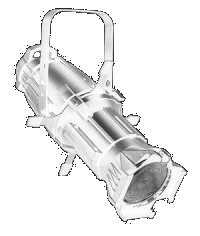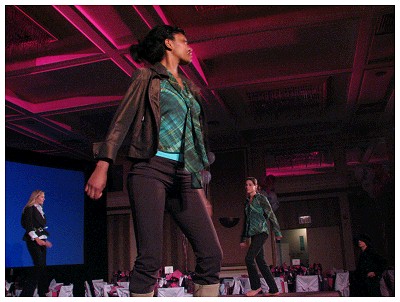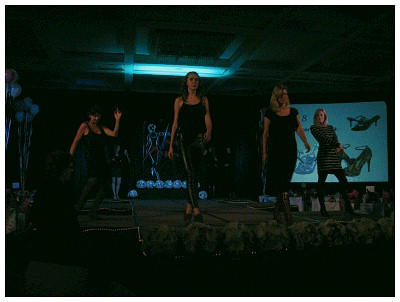

|
Photo Gallery Archive
|
(Although viewable at a 640-pixel horizontal
resolution, setting your browser to 800 or 1024
would be better for this page.
Events are in reverse chronological order.)
Simply the Breast
Breast Cancer Foundation Fundraiser
The Commonwealth Ballroom
Westin Nova Scotian Hotel
Halifax, Nova Scotia
October, 2009
Skip to Photos
|
This setup presented a number of |
|
|
|
|
These were solved by:
|
|
|
|
These first photos show the venue and runway before
the show and at the start of an earlier dress rehearsal.

|
Catering staff do final touches on the tables while
in the Center-Left background audio tech David
Slimming reviews music cues. At extreme Left and
Right Center, and partially obscured by balloons,
are towers with the show's front lighting fixtures.
That consists of 1000-watt, PAR 64 medium and wide
floods, plus a 1000-watt, 19-degree ellipsoidal
for the MC.
|

|
A closer look shows ceiling and rear curtain lighting.
Medium floods from the front towers create the oblique
pink wash, while PAR 64 narrow spots from the floor hit
the divider above the runway with turquoise. The curtain
blues are from the floor via 500-watt, 150mm fresnels.
|
|
Note the extra dimension created by exaggerating
the ceiling structure, and how much the separation
appears to increase between the rear curtain and
the upstage center sign. Compare that to the
apparent separation under regular room
lighting as seen in the previous photo.
|
Dress Rehearsal Photos
 Models rehearse for an early act in the show. At the top, a reflection of the ceiling in one of the wall mirrors, but direct light has been masked from the mirror itself. Note the video screen in the left background with just a raster and no image. Video was not included in this rehearsal. Choreographer Penny Evans can be seen directing this sequence at Lower Right. |
 |
Note the rows of lights outlining the runway and
`T' sections. These are rope lights. They consist
of strings of tiny, low-voltage, grain-of-wheat
lamps within a transparent plastic tube. These
are so small that each presents just a pinpoint
of light.
|
The Shoes Act
Subtle atmosphere and music sees three girls lying down
with their arms and legs crossed in the air to start.
Lighting is a front deep blue with a top turquoise. As
they and other models come out, the front white is brought
up to a dull level to bring them out of the blue. Dim
rope lights are also added for this. During the actual
show, in their hands will be various shoe styles. As
this act unfolds, the runway lighting comes up brighter;
finally, the girls freeze pose prior to a blackout. Again,
the choreographer can be seen directing their positions.
 |
 |
 |
 |
This was taken during the show. One can
see how the final pose turned out with
shoes in hand.
|
 Another show photo. It illustrates how the runway lighting can be bright yet masked from the mirrors at the top. Some light does spill on to the video screen, but careful focusing sees that it's not enough to dilute the image to a point where it becomes unviewable. |
|
Thanks to photographer Ian Fleming of Dartmouth, Nova Scotia for
usage of his photos. |
|
Return to the |
Return to the |
|
Go to the | |